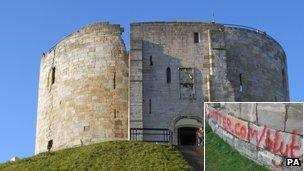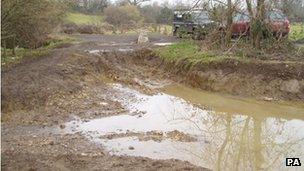Thousands of listed buildings damaged by crime: English Heritage
- Published

The survey included the example of graffiti on 11th Century Clifford's Tower, in York
Thousands of historic listed buildings in England are being damaged by crime every year, English Heritage fears.
Researchers surveyed 609 owners in October and November last year and their findings suggest almost a fifth of all sites - some 70,000 buildings - could have been harmed in 2011.
Metal theft was the most common crime, with churches most at risk.
English Heritage chief executive Simon Thurley said irreparable damage meant "centuries of history will be lost".
The survey cites a man spray-painting his Twitter account details on the 11th Century Clifford's Tower in York.
Other examples included the repeated theft of roof metal from a Hampshire church, whose organ was subsequently ruined by leaks.
English Heritage interviewed the owners of listed buildings and heritage sites by phone for the survey and then, based on the sample size, drew up estimates of the total number of those affected across the country.
The survey found that anti-social behaviour including flytipping and illegal metal detecting for treasure were the biggest problems at scheduled monuments such as prehistoric stone circles and archaeological sites.
Dr Thurley said the listed buildings and archaeological sites had a high value to society and the figures contained in the survey were alarming.
"Whilst heritage is not necessarily being targeted over other places, save perhaps for their valuable materials and artefacts, they are suffering a substantial rate of attrition from crime nonetheless," he said.
"Their particular vulnerability warrants every effort to ensure they are still around for future generations to enjoy just as much as we enjoy them now."
Janet Gough, director of the Church of England's cathedrals and church buildings division said buildings holding "many generations of memory" were being desecrated.
"Churches are fighting back against crime with increased security measures and vigilance but are not able to bear the threat and cost of crime indefinitely," she said.
Custodial sentence
English Heritage said 100 organisations had joined a voluntary network to systematically tackle heritage crime.
The Alliance to Reduce Crime against Heritage (Arch) is made up of enforcement bodies, local authorities, non-governmental organisations, professional groups and amenity societies.

English Heritage said a group in a four-wheel drive had driven over the remains of a Roman settlement
English Heritage has also signed a memorandum of understanding with the police and Crown Prosecution Service. The group said it had been trying to introduce heritage impact statements in courts so that sentencing for heritage crimes was appropriate to the nature of the offending.
It said that an impact statement it had provided in the case of the man who vandalised Clifford's Tower had contributed to his being given a custodial sentence.
Richard Crompton, Chief Constable of Lincolnshire and the Association of Chief Police Officers national lead for heritage crimes, said it was right that police took such crimes seriously.
"Across the police there is a growing recognition that heritage crime is not victimless," he said.
Heritage Minister John Penrose said the survey made depressing reading.
"When historic buildings and sites fall victim to vandalism, damage and theft, it's not just the owner who suffers," he said. "Very often the thing that's been stolen or damaged is literally irreplaceable, and the whole community is the loser."
The survey was carried out by Newcastle University, Loughborough University and the Council for British Archaeology.
It looked at listed buildings, unlisted buildings in conservation areas, scheduled monuments, and historic parks and gardens and based its figures on the sample size.
- Published27 February 2012
- Published23 February 2012
- Published5 January 2012
- Published1 January 2012
- Published10 June 2011